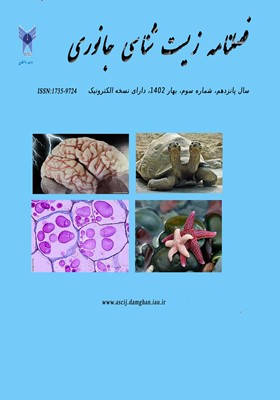اثر آتورواستاتین بر میزان هورمونهای جنسی و شاخص استرس اکسیداتیو در سندرم تخمدان پلیکیستیک القا شده توسط لتروزل در موشهای صحرایی ماده بالغ نژاد ویستار
محورهای موضوعی : فصلنامه زیست شناسی جانوری
شمسی زواری
1
,
اکرم عیدی
2
*
,
پژمان مرتضوی
3
![]() ,
شهربانو عریان
4
,
شهربانو عریان
4
![]()
1 - گروه زیستشناسی، واحد علوم و تحقیقات، دانشگاه آزاد اسلامی، تهران، ایران
2 - گروه زیستشناسی، واحد علوم و تحقیقات، دانشگاه آزاد اسلامی، تهران، ایران
3 - گروه دامپزشکی، واحد علوم و تحقیقات، دانشگاه آزاد اسلامی، تهران، ایران
4 - گروه نورواندوکرینولوژی، دانشکده علوم زیستی، دانشگاه خوارزمی، تهران
کلید واژه: موش صحرایی, آتورواستاتین, لتروزول, سندرم تخمدان پلیکیستیک,
چکیده مقاله :
آتورواستاتین در حال حاضر یکی از رایج ترین داروهای بیماری های قلبی عروقی است و بهطور عمده برای کنترل عوامل خطر در بیماری های قلبی عروقی به خوبی اثر بخشی اش مورداستفاده قرار می گیرد. سندرم تخمدان پلی کیستیک (PCOS) یک اختلال شایع غدد درون ریز در زنان در سن باروری است و اغلب با یک سندرم متابولیک همراه است. در مطالعه حاضر اثر آتورواستاتین بر سندرم تخمدان القاء شده با لتروزول در موش های رت بالغ نژاد ویستار مورد بررسی قرار گرفت. در این مطالعه تجربی، رت ها بهصورت تصادفی به 8 گروه تقسیم بندی شدند. کنترل سالم، آتورواستاتین به تنهایی (دوزهای 10، 50 و 100 میلیگرم بر کیلوگرم وزن بدن بهطور خوراکی بهصورت روزانه)، آتورواستاتین (10، 50 و 100 میلی گرم بر کیلوگرم بهصورت خوراکی و روزانه) همراه با لتروزول (1 میلی گرم بر کیلوگرم بهطور خوراکی و روزانه) مصرف می کردند و تیمار به ترتیب انجام شد. تجویز آتورواستاتین 30 دقیقه قبل از دوز اول لتروزول آغاز شد و تا 30 روز ادامه داشت. حیوانات 24 ساعت بعد از آخرین دوز تیمار تشریح شدند. نمونه های خون از طریق خونگیری از قلب جمع آوری شد. سرم برای تعیین میزان استرادیول، LH، FSH تستوسترون جدا و ارزیابی شد. علاوه بر این فعالیت آنتیاکسیدانی بهوسیله اندازه گیری سطوح سوپراکسید دسموتاز (SOD)، کاتالاز (CAT)، گلوتاتیون پراکسیداز (GPX) و مالون دی آلدئید (MDA) در تخمدان هموژن شده آزمایش و بررسی شد. تیمار با آتورواستاتین بهصورت معنیداری اختلال هورمونی PCOS القاء شده را بهبود بخشید. آتورواستاتین میزان آنزیم های آنتیاکسیدانی شامل SOD، CAT، GPX را افزایش داد در حالی که میزان MDA را کاهش داد. مطالعات فوق اثرات محافظتی آتورواستاتین را برروی PCOS القاء شده با لتروزول در رت های آسیب دیده اثبات کرد. نتایج حاصل از این مطالعه نشان داد که تیمار با آتورواستاتین ممکن است بر PCOS القاء شده با لتروزول در رتها سودمند است.
Atorvastatin is currently one of the most commonly used drugs in the clinics for the treatment of coronary heart disease and is mainly used for the control of risk factors in coronary heart disease as well as in the improvement of prognosis. Polycystic ovary syndrome (PCOS) is a prevalent endocrinological disorder in reproductive-age women and is often associated with metabolic syndrome. In the present study, the effect of atorvastatin on letrozole-induced PCOS was investigated in adult female Wistar rats. The rats were randomly divided into 8 groups: normal control, atorvastatin (10, 50, and 100 mg/kg intragastrically, daily) alone, PCOS control rats (letrozole, 1 mg/kg, intragastrically, daily), atorvastatin (10, 50, and 100 mg/kg intragastrically, daily) together with (letrozole1 mg/kg, intragastrically, daily), and administration was performed accordingly. Administration of atorvastatin was started 30 min. before the first dose of letrozole and continued for up to 30 days. The animals were euthanized 24 h after the last dose of the administration. Blood samples were collected by cardiac puncture. Serum was separated and evaluated for determination of estradiol, LH, FSH, and testosterone levels. Moreover, antioxidant activity was tested by measuring using superoxide dismutase (SOD), catalase (CAT), glutathione peroxidase (GPX), and malondialdehyde (MDA) levels in ovary homogenate. Our results showed that the administration of atorvastatin significantly improved PCOS-induced hormonal impairment. Also, the administration of atorvastatin increased the levels of antioxidant enzymes, including SOD, CAT, and GPX, while decreasing MDA levels. Taken together, the results of this study suggest that atorvastatin administration may be beneficial in letrozole-induced PCOS in rats. s.
_||_

